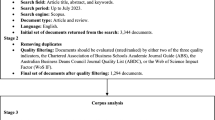Abstract
In this paper we propose a range of dynamic data envelopment analysis (DEA) models which allow information on costs of adjustment to be incorporated into the DEA framework. We first specify a basic dynamic DEA model predicated on a number of simplifying assumptions. We then outline a number of extensions to this model to accommodate asymmetric adjustment costs, non-static output quantities, non-static input prices, and non-static costs of adjustment, technological change, quasi-fixed inputs and investment budget constraints. The new dynamic DEA models provide valuable extra information relative to the standard static DEA models—they identify an optimal path of adjustment for the input quantities, and provide a measure of the potential cost savings that result from recognising the costs of adjusting input quantities towards the optimal point. The new models are illustrated using data relating to a chain of 35 retail department stores in Chile. The empirical results illustrate the wealth of information that can be derived from these models, and clearly show that static models overstate potential cost savings when adjustment costs are non-zero.
Similar content being viewed by others
References
Afriat, S.N. (1972). “Efficiency Estimation of Production Functions.” International Economic Review, 13, 568–598.
Boles, J.N. (1966). “Efficiency Squared-Efficiency Computation of Efficiency Indexes.” In Proceedings of the 39th Annual Meeting of Western Farms Economic Association, pp. 137–142.
Banker, R.D. and R.C. Morey. (1986). “Efficiency for Exogenously Fixed Inputs and Outputs.” Operations Research, 34, 513–521.
Chambers, R.G. (1988). Applied Production Analysis: A Dual Approach. Cambridge University Press, New York.
Charnes, A., W.W. Cooper, and E. Rhodes (1978). “Measuring the Efficiency of Decision Making Units.” European Journal of Operational Research, 2, 429–444.
Cooper, W.W., L.M. Seiford, and K. Tone. (2000). Data Envelopment Analysis: A Comprehensive Text with Models, Applications, References and DEA-Solver Software. Kluwer Academic Publishers, Boston.
de Mateo, F. (2003). Incorporation of Costs of Adjustment in DEA Models Selection of Optimal Paths. Ph.D. Thesis, University of New England, Armidale, Australia.
Epstein, L.G. (1981). “Duality Theory and Functions Forms for Dynamic Factor Demand.” Review of Economic Studies, 48, 81–95.
Färe, R., S. Grosskopf, and C.A. Lovell. (1994). Production Frontiers. Cambridge University Press, Cambridge.
Färe, R., S. Grosskopf, and C.A. Lovell. (1985). Measurement of Efficiency of Production. Kluwer-Nijhoff Publishing Co., Boston.
Färe, R. and S. Grosskopf. (1996). Intertemporal Production Frontier. Kluwer Academic Publishers, Boston.
Farrel, M.J. (1957). “The Measurement of Productive Efficiency.” Journal of Statistical Society, Series A, CXX, Part 3, 253–290.
Golany, B. and Y. Roll (1993). “Some Extensions of Techniques to Handle Non-discretionary factors in DEA.” Journal of Productivity Analysis, 4, 419–432.
Luh, Y. and S. Stefanou (1996). “Estimating Dynamic Dual Models under Nonstatic Expectations.” American Journal of Agricultural Economics, 78, 991–1003.
McLaren, K. and R. Cooper (1980). “Intertemporal Duality: Application to the Theory of the Firm.” Econometrica, 7, 1755–1762.
Nemoto, J and M. Goto (1999). “Dynamic Data Envelopment Analysis: Modeling Intertemporal Behavior of a Firm in the Presence of Productive Inefficiencies.” Economics Letters, 64, 51–56.
Nemoto, J and M. Goto (2003). “Measurement of Dynamic Efficiency in Production: An Application of Data Envelopment Analysis to Japanese Electric Utilities.” Journal of Productivity Analysis, 19, 191–210.
Sengupta, J.K. (1995). Dynamics of Data Envelopment Analysis. Theory of Systems Efficiency. Kluwer Academic Publishers, Dordrecht.
Staat, M. (1999). “Treating Non-discretionary Variables One Way or the Other: Implications for Efficiency Scores and Their Interpretation.” In Westermann, G. (ed.), Data Envelopment Analysis in the Service Sector. Deutscher Universitäts-Verlag, Wiesbaden, pp. 23–49.
Treadway, A.B. (1970), “Adjustment Costs and Variable Inputs in the Theory of the Competitive Firm.” Journal of Economic Theory, 2, 329–347.
Author information
Authors and Affiliations
Corresponding author
Additional information
This paper arises out the senior author's PhD thesis at the University of New England, Australia. The authors gratefully acknowledge Dr. George E. Battese for his comments on earlier drafts of this work.
Rights and permissions
About this article
Cite this article
Mateo, F.d., Coelli, T. & O'Donnell, C. Optimal Paths And Costs Of Adjustment In Dynamic DEA Models: With Application To Chilean Department Stores. Ann Oper Res 145, 211–227 (2006). https://doi.org/10.1007/s10479-006-0034-7
Published:
Issue Date:
DOI: https://doi.org/10.1007/s10479-006-0034-7




